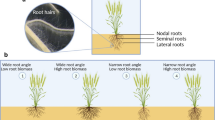Abstract
Understanding the genetic factors governing developmental patterns and flowering time in breeding materials is required for the development of new wheat varieties for a specific environment. Iran is among the largest wheat producers in the arid and semi-arid regions of the Middle East and North Africa. The wheat germplasm grown in Iran is either developed nationally or is introduced from the CIMMYT global wheat program. For decades, the wheat breeding program in Iran focused on generating new varieties better able to grow in the predominant Iranian climatic conditions such as humidity at the reproductive stage, high temperature during reproductive stages (terminal heat stress), moderate temperature during the cropping season, and high probability of frost damage during early stages of growth. There have also been sub-programs aimed at developing drought and salinity-tolerant wheat cultivars in Iran. Knowledge of cultivars’ growth habits in Iran is currently limited to flowering in spring-sown nurseries. We identified allelic diversity in loci involved in vernalization response (Vrn) and photoperiod sensitivity (Ppd) in 60 bread wheat cultivars developed in Iran, CIMMYT, or ICARDA. This study revealed that the spring growth habit observed in most of the cultivars is conferred by a combination of recessive vrn-A1 and dominant Vrn-D1, Vrn-B1, and/or Vrn-B3 loci. This implies that most of the cultivars have minimal vernalization requirements for overwintering. Perhaps cold winters, even in the southern regions of Iran, provide sufficient vernalization conditions for cultivars possessing the recessive vrn-A1 allele. The germplasm investigated in this study revealed no evidence indicating selection for or against any specific Vrn and Ppd allele in our wheat breeding program.
Similar content being viewed by others
References
Beales J, Turner A, Griffiths S, Snape JW, Laurie DA. 2007. A pseudo-response regulator is misexpressed in the photoperiod insensitive Ppd-D1a mutant of wheat (Triticum aestivum L.). Theor. Appl. Genet. 115: 721–733
Cockram J, Jones H, Leigh FJ, O’sullivan D, Powell W, Laurie DA, Greenland AJ. 2007. Control of flowering time in temperate cereals: Genes, domestication, and sustainable productivity. J. Exp. Bot. 58: 1231–1244
Díaz A, Zikhali M, Turner AS, Isaac P, Laurie DA. 2012. Copy number variation affecting the photoperiod-B1 and vernalization-A1 genes is associated with altered flowering time in wheat (Triticum aestivum). PLoS One 7: e33234
Dubcovsky J, Lijavetzky D, Appendino L, Tranquilli G. 1998. Comparative RFLP mapping of Triticum monococcum genes controlling vernalization requirement. Theor. Appl. Genet. 97: 968–975
Dyck JA, Matus-cadiz MA, Hucl P, Talbert L, Hunt T, Dubuc JP, Nass H, Clayton G, Dobb J, Quick J. 2004. Agronomic performance of hard red spring wheat isolines sensitive and insensitive to photoperiod. Crop Sci. 44: 1976–1981
Fu D, Szucs P, Yan L, Helguera M, Skinner JS, von Zitzewitz J, Hayes PM, Dubcovsky J. 2005. Large deletions within the first intron in VRN-1 are associated with spring growth habit in barley and wheat. Mol. Genet. Genomics 273: 54–65
Galiba G, Quarrie SA, Sutka J, Morgounov A. 1995. RFLP mapping of the vernalization (Vrn1) and frost resistance (Fr1) genes on chromosome 5A of wheat. Theor. Appl. Genet. 90: 1174–1179
Goncharov NP. 2004. Response to vernalization in wheat: Its quantitative or qualitative nature. Cereal Res. Commun. 32: 323–330
Herndl M, White JW, Hunt LA, Graeff S, Claupein W. 2008. Field-based evaluation of vernalization requirement, photoperiod response and earliness per se in bread wheat (Triticum aestivum L.). Field Crops Res. 105: 193–201
Iqbal M, Navabi A, Yang RC, Salmon DF, Spaner D. 2007. Molecular characterization of vernalization response genes in Canadian spring wheat. Genome 50: 511–516
Iqbal M, Shahzad A, Ahmed I. 2011. Allelic variation at the Vrn-A1, Vrn-B1, Vrn-D1, Vrn-B3 and Ppd-D1a loci of Pakistani spring wheat cultivars. Electron. J. Biotechnol. 14: 1–8
McIntosh RA, Devos KM, Dubcovsky J, Rogers WJ, Morris Appels CFR, Sommers DJ, Anderson OA. 2007. Catalogue of gene symbols for wheat (supplement) Available at: http://wheat.pw.usda.gov/GG2/maps.html (Last access on June, 26th 2012).
Porter JR, Gawith M. 1999. Temperatures and the growth and development of wheat: A review. Eur. J. Agron. 10: 23–36
Pugsley AT. 1971. A genetic analysis of the spring-winter habit of growth in wheat. Aust. J. Agric. Res. 22:21–23
Pugsley AT. 1972. Additional genes inhibiting winter habit in wheat. Euphytica 21: 547–552
Richards RA. 1996. Defining selection criteria to improve yield under drought. Plant Growth Regul. 20: 157–166
Shindo C, Sasakuma T. 2002. Genes responding to vernalization in hexaploid wheat. Theor. Appl. Genet. 104: 1003–1010
Snape JW, Butterworth K, Whitechurch E, Worland AJ. 2001. Waiting for fine times: Genetics of flowering time in wheat. Euphytica 119: 185–190
Worland T, Snape JW. 2001. Genetic basis of worldwide wheat varietal improvement. In AP Bonjean, WJ Angus, eds, The World Wheat Book: A history of wheat breeding. Lavoisier Publishing, Paris, pp 61–67
Yan L, Fu D, Li C, Blechl A, Tranquilli G, Bonafede M, Sanchez A, Valarik M, Yasuda S, Dubcovsky J. 2006. The wheat and barley vernalization gene VRN3 is an orthologue of FT. Proceedings of the National Academy of Science, USA, 103: 19581–19586
Yan L, Helguera M, Kato K, Fukuyama S, Sherman J, Dubcovsky J. 2004. Allelic variation at the VRN-1 promoter region in polyploid wheat. Theor. Appl. Genet. 109: 1677–1686
Zhang XK, Xia XC, Xiao YG, Dubcovsky J, He ZH. 2008. Allelic variation at the vernalization genes Vrn-A1, Vrn-B1, Vrn-D1 and Vrn-B3 in Chinese common wheat cultivars and their association with growth habit. Crop Sci. 48: 458–470
Author information
Authors and Affiliations
Corresponding author
Rights and permissions
About this article
Cite this article
Mohammadi, M., Torkamaneh, D. & Mehrazar, E. Molecular examination and genotype diversity of vernalization sensitivity and photoperiod response in old and modern bread wheat cultivars grown in Iran. J. Crop Sci. Biotechnol. 15, 259–265 (2012). https://doi.org/10.1007/s12892-012-0077-z
Received:
Revised:
Accepted:
Published:
Issue Date:
DOI: https://doi.org/10.1007/s12892-012-0077-z




